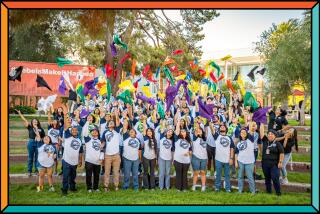Counting on Students
PACOIMA â It was not a trick question, and these teens are no slackers.
As student leaders, they routinely scrounge up buckets and volunteers for school carwashes, hoof the streets as political campaigners and hold fast to big dreams, far beyond the nurturing gates of San Fernando High School.
Yet the question--âWho can tell me what they know about the census?â--stumped all but two of the 60 in the leadership and student government classes.
A census form takes only 10 minutes to fill out, explained Flor Mendoza, a social studies teacher and student government advisor. But the nationâs head count, taken every decade, has far-reaching effects, she told students.
In California, it may mean two more congressional seats. Closer to home, Mendoza explained how census results help determine funding for the studentsâ own high school.
âI urge you to see if you can help me,â Louisa Ollague, MALDEFâs regional census director, told the San Fernando High teens Tuesday. âWe need your help to volunteer with MALDEF or to work for the Census Bureau.â
With that as an opener, it took less than an hour for many of the teens to become converts to the Hagase Contar!, or Make Yourself Count, campaign by the Mexican American Legal Defense and Educational Fund.
MALDEF is banking on its community-education program to boost Latino participation when census forms arrive at homes in March.
After the 1990 census, Census Bureau officials said they missed 5% of Latinos, 4.4% of African Americans, 2.3% of Asians and Pacific Islanders and 12.2% of Native Americans on reservations.
Census officials also estimate there are now 10.5 million Latino children--the largest minority group among children. Because more than half of Latino children were not counted in the 1990 census, officials say the 2000 census will be especially critical.
The schools may be key to reducing those undercounts, MALDEF officials said. In partnership with the Los Angeles Unified School District, MALDEF is targeting high schools in census tracts with low census form mail-in rates.
If students get excited about the decennial census, they will encourage their parents to fill out the forms, officials theorize. Teens can also educate their families to count all kids, debunk community fears about the governmentâs efforts to count every person--citizen or not--and remind parents the data is confidential.
Ollague also told the students that the Census Bureau has jobs--that start at $11.75 an hour and would utilize their Spanish language skills--for those who are 18 or older. That perked up many of the studentsâ ears.
After Ollagueâs presentation to the schoolâs student leaders, Christine Vega, 17, signed up for three hours of volunteer training on an upcoming Saturday. Sometime in January, she and other classmates will hit the streets to ask local merchants to put up Hagase Contar! posters in store windows.
Vega is no novice to grass-roots activism. The Pacoima teen said she observed Antonio Villaraigosaâs campaign for Assembly, and is eager to help persuade her parents and her neighborhood to participate in this springâs census.
William Teal, 16, of Pacoima, also signed on as a volunteer and said his first efforts will begin at home to persuade his skeptical parents the census data will remain confidential.
Thatâs often the role of many first-generation teens in the United States, said Isai Perez, a Census Bureau community partnership specialist who works in the northeast Valley.
âThere are a lot of tracts in that area that had less than 50% [census form] mail-response rates,â Perez said. â[The teens] really keep their parents in check when it comes to filling out important documents that affect their future and their community.â
In 1990, the national average response rate was 65%, with Los Angeles slightly behind at 60%, according to the Census Bureau.
The city of San Fernando, with its many longtime homeowners, beat both national and Los Angeles statistics with a 67% response rate. But MALDEF found that many Los Angeles census tracts had dismal results.
For example, in a census tract east of downtown Los Angeles near Alameda Avenue and 7th Street, the rate was 30.1%. In the Valley, a Pacoima tract near Van Nuys and Glenoaks boulevards and San Fernando Road had a rate of 49.6%.
San Fernando High student Antonio Sanchez, 17, of Van Nuys, said he recently heard about the census from a Spanish-language radio ad.
âIt happens once every 10 years, and Iâd like to know about it and get informed,â said Sanchez, the schoolâs vice president of reform, who usually deals with issues such as lobbying for cleaner restrooms and cracking down on tagging. âIâm going to talk to my mother about it.â
More to Read
Sign up for Essential California
The most important California stories and recommendations in your inbox every morning.
You may occasionally receive promotional content from the Los Angeles Times.










